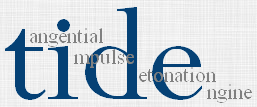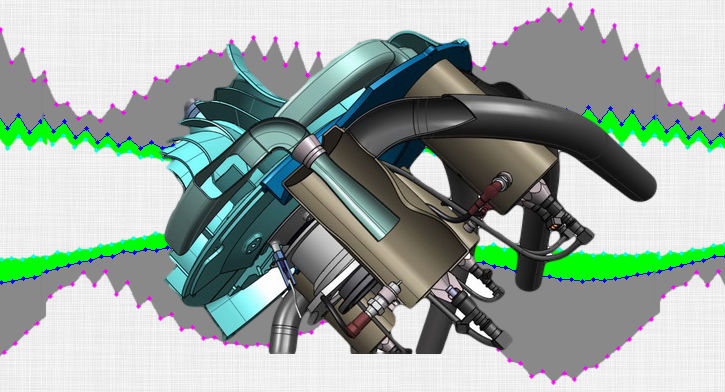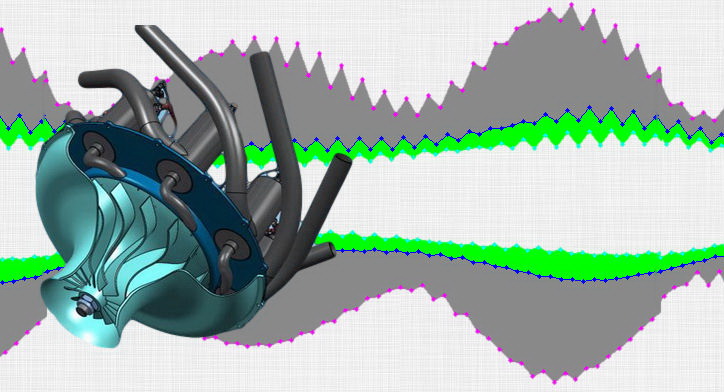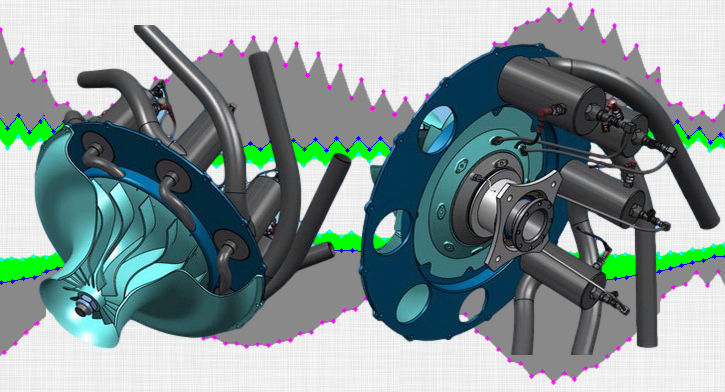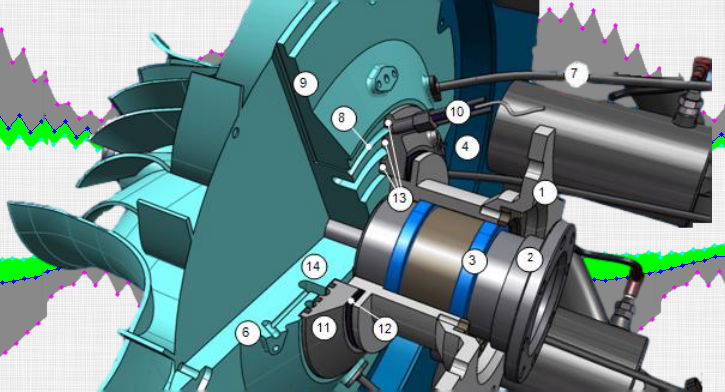The parteners involved in this project:
| 1 |
INSTITUTUL NATIONAL DE CERCETARE-DEZVOLTARE TURBOMOTOARE - COMOTI
|
Romania |
| 2 |
LUNDS UNIVERSITET LTH |
Sweden |
| 3 |
INSTITUT VON KARMAN DE DYNAMIQUE DES FLUIDES VKI |
Belgium |
| 4 |
INSTITUTE OF APPLIED PHYSICS OF THE ACADEMY OF SCRIENCES OF MOLDOVA (IAP) |
Republic of Moldova |
1. ROMANIAN RESEARCH
AND DEVELOPEMENT INSTITUTE FOR GAS TURBINES - COMOTI - Romania
Founded in 1985, the National (Romanian) Research and Development
Institute for Gas Turbines COMOTI (since 1996), of Bucharest, a research SME, is the only unit in
Romania specialized in the development and integration of scientific research, constructive and
technological design, manufacturing, experimentation, testing, technological transfer and
innovation in the field of aviation and industrial gas turbine engines and high speed bladed
machines. COMOTI is active in the field of aviation turbine engines, computer aided design and
manufacturing, structural and fluid dynamics computations, data acquisition. The experience gathered in the
field of high speed bladed machines allowed development, in own conception, of series of electrical
centrifugal natural gas or air compressors and electrical centrifugal air blowers in a large
variety of flows and pressures, making COMOTI the only national producer for such complex equipments.
Internationally, institutional and professional proficiency of COMOTI in the field of gas
turbine engines and high speed blade machines has been acknowledged by winning a significant
number of medals and diplomas in international expositions held in Geneva and Brussels.
COMOTI owns over 30 invention patents in the field of gas turbines. The institute employs a
staff of 180 people, over 50% being University graduates and 15 people holding a doctoral degree.
COMOTI has participated in several high enterprise European projects,
within FP V, FP VI, FP VII,
and CleanSky(SILENCER, METHOD, JEAN, ABRANEW, CoJeN, VITAL, XNOISE 2,
TEENI,
OPENAIR, ESPOSA, HEXENOR) where it was involved in experimental
programs, in numerical
simulation tasks, and in the design and manufacturing of gas turbine
engine components.
The compressors and fans department owns experimental stands for fans
and compressors. Its main
activity is the design of compressors and fans, including detail and
assembly drawings, and
instrumentation and experimental testing of compressors and fans. The
department participates in
European projects like X-Noise EV, ELTESTSYS, STARTGENSYS and ESPOSA.
The
experimental team of the department recently tested screw compressors
for the oil industry and a air
centrifugal compressors, 9-125 Linde, for the commercial agent LINDE,
Hungary. Recently,
TIDE 335091
42
COMOTI gathered experience in axial fans by participating in two major
European Research
projects, Silencer (finished in 2007) and VITAL (finished in 2010) and
two national projects
“Advanced computation, design, analysis and execution methods of the
aviation marks – DOUBLE
FLUX engine’s fan” finished in 2007 and “Realization and validation of a
calculus system program
for the aero elastic analysis of aircrafts and turboengines compressors”
finished in 2011. The
department also participated in national projects involving CFD studies
regarding different devices
like centrifugal separators, jets, gas accumulation situations.
In the field of reactive flow CFD, COMOTI successfully coordinated a
national program
(Partnerships 2007 - 81-024; LEMLES) that had the goal of developing,
implementing and
experimentally validating a numerical algorithm for simulating complex
reactive turbulent flows,
algorithm that will be used as the main LES solver in this project.
Also, CO successfully
coordinated another national program (Partnerships 2007 - 21-002;
POSTCOMB) that used the
previously mentioned numerical algorithm for the design of a
post-combustion system.
The Combustion and Laserometry Laboratory in COMOTI owns a thermo –
gas-dynamic
experimental complex to be described in the next paragraphs. In the most
recently completed
European research activities, in the FP 7 program 212367 - TEENI, the
combustion team carried out
experimental measurements of temperature, acoustic pressure and
instantaneous velocity (using
PIV) in the hot flow downstream of a combustor. Experimental
measurements of temperature (using
Rayleigh spectroscopy) and gas composition (using PLIF) will be carried
out in the European
research project 284859 - ESPOSA.
The research team of the automation department is a flexible structure
which very easily adapts to
any research theme from the specific domain. It consists of
electro-technical and electronics
engineers, graduates of the aerospace engineering and mechatronics
engineering departments, and
specialized in top technical domains such as: processes control, IT,
automation of turbine engines
and anti-explosion protection. The team was involved in numerous
economic contracts with an
important research component, finalized or in progress, with
beneficiaries such as OMV PETROM,
TRANSGAZ.
On the manufacturing and testing side, COMOTI participated in a number
of European research
programs (VITAL, SILENCER, TEENI, HEXENOR, ESPOSA) where it was involved
in various
new gas turbine engine parts manufacturing tasks. Also test rig
adaptation parts for experimental
research programs were designed and manufactured by COMOTI.
Key persons:
dr. Ionuţ Porumbel - Project Coordinator
Born in 1968. Experience in coordinating European research
projects, gained as COMOTI research team coordinator in the
FP 7 Programs.
Author of one book on numerical combustion and 13 scientific
papers published in peer reviewed journals and conference
proceedings.
Author of one invention patent (pending).
Over 10 years experience in gas turbines and combustion
chambers.
dr. Cristian Cârlănescu – WP 5
(Experimental Concept Validation) Leader
Born in 1949, Head of Combustion and Thermal Coating
Laboratory in COMOTI.
Author of two books on gas turbines, including experimental
methods, and over 58 scientific papers published in peer
reviewed journals and conference proceedings.
Author of more than 20 invention patents (one pending).
Over 30 years experience in gas turbines and combustion
chambers.
Adrian Toma – WP 4 (Manufacturing and
Assembly) Leader
Born in 1968, design engineer with a 20 years experience in
the Technology Research Laboratory
of COMOTI and 10 years experience as a designer of non
destructive testing equipments
Bogdan Gherman – Compressor Module Leader
Born in 1977. Researcher and design engineer with a good
knowledge of CFD and he worked with four CFD codes, namely
ANSYS FLUENT, STAR-CD, ANSYS CFX and NUMECA. He has a seven
years experience in the CFD field;
he has a Licentiate of Engineering in obtained in 2004 in
Lund, Sweden at Lund Institute of Technology.
He published nine papers regarding the combustion process,
thermo acoustics, reactive jets, swirling flows and
compressors aerodynamics in peer
reviewed renowned conference proceedings.
dr. Constantin Eusebiu Hriţcu –
Combustor Module Leader
Born in 1965. Post graduation specialization was
accomplished in the domain of pulse combustion chambers,
which materialized into his Ph. d. thesis entitled “Research
on Pulse Operating Combustion Chambers”, patent that won
silver medal at the International Exhibition of Inventions
of Geneva.
Head of the "Fuel Injection & Combustion Chambers"
Laboratory, of COMOTI's Iasi subsidiary.
12 years of experience in research in the field of gas
turbines, and another 7 years of design experience.
dr. Cleopatra Florentina Cuciumita –
Engine Module Leader
Born in 1984. Experience in participating in European
research projects, gained as COMOTI research team member in
the FP 7 Programs
Author of one book chapter on gas turbines and 15 scientific
papers published in peer reviewed journals and conference
proceedings.
Author of one invention patent.
Over 4 years experience in gas turbines and axial turbines.
dr. Gabriel Ursescu – Engine Design
Born in 1968. Significant experience in European research
project as a member of the COMOTI research team in the FP7
Programs
Since 2003 he is also involved in teaching and research in
the field of automotive engineering.
His design experience was enhanced during his activity as a
Research Scholar at the Centre for Automotive Research at
the Ohio State University in Columbus, OH, USA, that was the
source of several scientific papers and two US Patents (one
granted patent and one registered application).
Besides the scientific activity, he led the design and
development of two concept vehicles one of which is a
hybrid. Both projects were developed with students.
He is also coordinator of the Formula Student Competition
Team at the “Gheorghe Asachi” Technical University.
2. LUND UNIVERSITY
- Sweden
Lund University is a world-class university that works to
understand, explain and improve our world and the human
condition. The University is ranked as one of the top 100 in
the world and tackled complex problems and global challenges
and work to ensure that knowledge and innovations benefit
society. LTH provided education and research in engineering,
science, law, social sciences, economics and management,
medicine, humanities, theology, fine art, music and drama.
Our 47 000 students and 6 800 employees are based at their
campuses in Lund, Malmö and Helsingborg. LTH is an
international university with global recruitment, cooperate
with 680 partner universities in over 50 countries and are
the only Swedish university to be a member of the strong
international networks LERU (the League of European Research
Universities) and Universitas 21.
LTH will be involved in the project through its Division of
Fluid Mechanics. The Division of Fluid Mechanics is part of
the Department of Energy Sciences of the Faculty of
Engineering of Lund University. The division focuses on
study of turbulent flows with an emphasis on modeling
multiphysics system. The division has nearly 20 years of
experience in high quality research applying Large Eddy
Simulation to reacting and multiphase flows. The main
application areas for the research are energy conversion and
biomedical flows. More recently, an activity modeling
compressor aerodynamics and fluid structure interaction was
initiated. The reacting flow activities focus on combustion
modelling (model development for LES) as well as application
to gas turbines and Diesel engines. The division consists of
21 persons (4 senior researchers, 2 postdocs and 15 PhD
students).On average between 2 and 4 PhD students have
defended their thesis each year since 1999.
Key persons:
Prof. Johan Revstedt - WP 2 (Numerical Simulations) Leader
Born in 1967, professor of mechanics at the department of
Energy Sciences at Lund University.
Since 1999, prof. Revstedt’s research
has been focused on the study of multi-phase and
fluid-structure interaction using large eddy
simulation. He has also developed methods for representing
complex geometries on Cartesian grids, e.g. immersed
boundary methods.
Prof.Revstedt
has 26 publications in peer reviewed journals and 42
conference contributions.
He is also reviewer for several journals within fields of
fluid mechanics and chemical engineering.
dr. Christophe Duwig - Combustion Numerical
Simulation
Born in 1974. Associate professor in the department of
energy sciences at Lund University.
Since 2003, Dr.Duwig has pursued model development for
turbulent combustion simulation in particular using large
eddy simulation. He has also continuously been working with
gas turbine modelling in collaboration with Siemens AB
(Finspång Sweden).
Dr.Duwig has also contributed to the analysis of reacting
flows using modal decomposition.
He is principal investigator for several research projects
founded by the Swedish Research Council (Vetenskaprådet)
focusing on combustion modelling and turbulent combustion
simulation.
Dr.Duwig has more over 22 scientific papers published in
peer reviewed journals (h-factor 7 on 2012-01-01) and is
regularly reviewing paper for top journals in the field of
combustion.
Dr.Duwig has also been active in the field of alternative
fuel combustion and new combustion technologies leading to 5
patents.
3. VON KARMAN
INSTITUTE FOR FLUID DYNAMICS
- Belgium
The Von Karman Institute, founded in 1956, is a non profit
international centre for post graduate education and
research in fluid dynamics. The educational program based on
the concept of “training in research by doing research”
includes a Research Master in fluid dynamics, attended by
30-35 students per academic year, and a Ph.D. research
program involving 30-40 candidates.
The technical staff consists of 92 members, with research
activities oriented towards aeronautical issues, propulsion,
energy production, industrial processes and environmental
problems. A large number of advanced experimental facilities
are available in the domain of aerospace, aeronautical and
industrial fluid dynamics. They cover a large span, ranging
from low speed to hypersonic.
Experimental research is complemented by an important
activity in the domain of Computational Fluid Dynamics
(CFD). The institute is one of the pioneers in the
development and use of new numerical schemes and has over 20
years of experience in the optimization and design
techniques.
Many of the research activities carried out at the von
Karman Institute are supported by research contracts with
industry or governmental institutions.
The Turbomachinery and Propulsion department of the VKI
already participated in a number of European Research
projects in the past (e.g. Wake Mixing, IACA, TATEF, TATEF2,
AITEB, AITEB2, UTAT, ADVACT, LAPCAT, LAPCAT2, VITAL, DREAM,
FACTOR, ACOCTH, DINNOCROR, etc... ) related to aero-thermal
research in propulsion.
Key persons:
dr. Guillermo Paniagua - WP 1 (Preliminary
Concept Design) Leader
Born in 1972, currently Associate professor in both the
Aerospace department and the Turbomachinery and propulsion
department.
He also lectures at the University of Valencia. He has 15
years of experience on experimental and numerical
aerothermal study of high-speed flows.
His main area of research is related to the experimental and
numerical aerothermal study of high-speed flows, in
particular, on high speed turbo machinery. Guillermo
authored over a hundred technical papers, has been awarded
four international prizes and a patent.
dr. Bayindir H. Saracoglu - Compressor - combustor - nozzle integration
Born in 1981, currently Senior Research Engineer in Aeronautics and Aerospace Department.
After completing his PhD studies at Wright State University, Ohio, USA, he has been involved in several European and international research projects. He has unique expertise in measurement techniques, flow visualizations, advanced data processing, active and passive flow control techniques, computational fluid dynamics, flow in turbomachinary and high-speed external flows.
He has authored 15 technical papers, 2 patents, and has produced numerous technical reports.
4. INSTITUTE OF APPLIED PHYSICS OF THE ACADEMY OF SCRIENCES OF MOLDOVA
(IAP)
- Republic of Moldova
IAP was created in 1964 and, since then, it was the main
research institution in Moldova in physics.
The theoretical and experimental activity of IAP is focused
on developing kinetic and statistic physics models for
condensed and nuclear matter phenomena, research and
development of chalcogenic semiconductors, metallo-organic
compounds and molecular magnets for storage media,
sensors, optical-electronic and photo-voltaic applications,
development of electrical-physicalchemical methods of
obtaining and processing new materials and coatings with
improved functional characteristics, development of advanced
electronic, optical-electronic and photonic technologies
and devices, intensification of heat and mass transfer
processes through electro-physical, hydrodynamic and
cavitation methods for food industry materials and
processes.
IAP employs 225 persons, among them - 156 researchers, 27
doctors-habilitate and professors, 72 Ph.D., 6 ASM
Academicians, 3 ASM Corresponding Members, 52 young
scientists (under 35). IAP is worldwide recognized through
its research studies in the fields of interest, its active
participation in various international conferences, its
scientific papers published in renowned journals and its
innovations.
Over the last 5 years, IFA participated in several
international projects, with partners from Germany, Belarus,
Ukraine, and Romania. IAP coordinates the process of
adhesion of the Republic of Moldova to the Southeastern
European Network in Mathematical and Theoretical Physics
scientific support program. IAP publishes an ISI journal
Surface Engineering and Applied Electrochemistry” and
organizes the Material Science and Condensed Matter Physics
conference (MSCMP).
IAP participates in the project through the Hydrodynamic
Processes and Electro-Flotation Laboratory. The main
activity of the Laboratory is to develop active static and
dynamic flow control methods, the intensification of heat
and mass transfer processes, the design and development of
pulsed flow generation devices in resonating or
self-oscillatory regimein the range of 10-10000Hz.
The Laboratory participated in two pulsed combustion
project, of which one in collaboration with COMOTI and dr.
Hritcu, and participated in several national programs
dealing with high pressure hydro-acoustic oscillations of
controlled amplitude and frequency.
Key persons:
Tudor Cuciuc - WP 3 (Geometrical Modeling
and Design) Leader
Born in 1953.Currently scientific researcher in the
Hydrodynamic Processes and Electro-Flotation Laboratory.
His main research interests include the experimental and
numerical study of one-phase and two-phase flows over solid
bodies, the intensification of heat and mass transfer
processes and the development of hydro-thermo-acoustic, high
intensity, large frequency range, pulsed jets generation and
control devices, particularly in the self-oscillating
regime.
Author of over 50 scientific papers, including ISI journals,
and two invention patents. Over 20 years expertise in
applied resonating pulsed combustion.
Petru Dumitras - Demonstrator design
Born in 1945. Doctor in technical sciences, head of the
Hydrodynamic Processes and Electro Flotation Laboratory.
He participated in several projects within the framework of
national and international programs.
He is author in over 100 scientific papers and 8 patents
implemented in enterprises from Moldova, Russia, Romania and
Ukraine.
